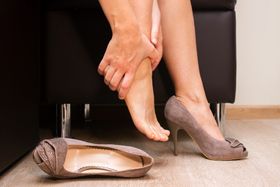What Is Acupressure and How Can It Relieve Heel Pain?
Updated December 18, 2024

Heel pain is one of the most common pains that most people generally experience. You can get heel pain from wearing uncomfortable shoes, and you can get heel pain after running. Many practices and techniques are used to manage this pain, one of them being acupressure.
Traditional Chinese Medicine has been around for years. While much of the western world continues to reject its practices, many are embracing its practices for pain management. Acupressure is one TCM practice that is gaining acceptance in the community because of its effectiveness in relieving pain symptoms.
Acupressure is a TCM practice that delivers sustained pressure to specific pressure points around the body to achieve pain relief. Although the evidence for its effectiveness may be low, acupressure seems effective in treating pain at the back of the heel.
In this post, we will further discuss which pressure points are located in the heel and what you need can do to relieve the pain when your heels hurt.
Which Pressure Points Are Located in the Heel?
There are up to fifteen pressure points in the heel, according to Traditional Chinese Medicine. These pressure points have a far-reaching effect that surpasses the feet to influence the whole body. By applying pressure to these areas, you can facilitate the flow of energy (qi) between the points and the organs they represent in the body. Once there is a restoration of harmony in the body meridians, pain relief also occurs.
The fifteen pressure points include the Tai Chong (LV 3), Yong Quan (KD 1), Da Dun (LV 1), Tai Bai, Tai Xi, Shen Mai, Qiu Xu, Kun Lun, and Xing Jian. Others are the Li Nei Ting, Xia Li, Zu Lin Qi, Gao Ya Xue Dian, Di Er Li Dui, and Di San Li Dui.
It is important to note that stimulating a pressure point on the heel does not mean you are treating the heel pain, but relieving it. Due to how body meridians work, many pressure points have links to organs located elsewhere in the body. Hence, if acupressure is to be used to address heel pain, you must be able to identify the specific pressure points in the feet which solve heel pain. Heel pain exercises also offer great pain relief techniques.
How Can Acupressure Relieve Heel Pain?
In TCM, heel pain is a result of Liver and Kidney yin deficiency. Consequently, if the desire is to relieve heel pain, you must start by addressing the pressure points associated with the two organs. There are at least three pressure points that can be used to treat heel pain. They are Tai Xi, Kun Lun, and Yong Quan.
When you apply pressure to any of these points, you'll experience pain relief. Several attempts to explain how these pressure points have led to differing opinions. Some think that the pressure causes the stimulation of larger nerve fibers and effectively blocks the perception of pain. Others assert that the pressure causes relaxation and the release of endorphins, which modify the pain perception. Lastly, the pressure may influence the autonomic nervous system and affect the heart, digestion, and breathing. One thing that seems sure, regardless of how you think it happens, is that acupressure points do relieve heel pain.
Additionally to the aforementioned, you can also make use of insoles for heel pain.
How to Use Acupressure to Relieve Heel Pain
There are at least three approaches to acupressure when the goal is pain relief. You can use either the massage technique, calf stretching exercise, or custom orthotics.
Massage
You can either use a manual massage or massage machine to deliver acupressure to relieve your heel pain. You may perform the massage on your own, or you may need a reflexologist/physiotherapist/someone skilled in acupressure to help you.
To perform the massage:
- Extend the toes and sole while applying pressure massage to all three acupressure points. You can use your thumb to apply the pressure. You can also use the cover of a pen to apply the pressure.
- Continue for 2-3 minutes.
- Relax and repeat.
To learn more about the other techniques that you can use, take a look at our post on How to Relieve Plantar Fasciitis Using Points.
Calf stretching
Calf stretching is a very useful heel pain exercise, to perform it:
- Stand shoulder-width apart. You can place your hands on the wall at chest level if you need support.
- Place one foot slightly ahead, ensuring the other remains straightened. Keep both feet flat on the ground.
- Lean forward on the straightened leg for 20-30 seconds. This move stretches the calf muscles on that leg.
- Stop and repeat on the other leg. Alternate between both legs up to 5 times each.
» Still not convinced? Check out our extensive guide on pressure points for plantar fasciitis
Use of Custom Orthotics
While heel massage and calf stretches can take care of the pain symptom, a custom orthotic that’ll deliver acupressure targets the root cause of the condition. Research evidence suggests that only a custom orthotic with fascia bar technology can effectively relieve heel pain.
Beyond making the feet more comfortable, the fascia bar technology lifts the heel while applying sustained pressure to the targeted points. Thus, it addresses the immediate pain symptoms while dealing with the long-term root cause.








